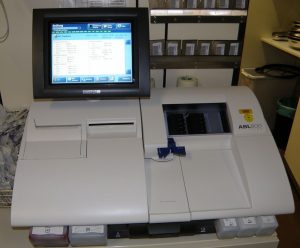A Complete ABG Interpretation
There are four parts to a complete ABG interpretation. The pH, pCO2 and HCO3 are used to determine the overall acid-base status of the blood. The pO2 is used to assess the oxygenation level of the blood. A clinician must determine if the blood sample is:
- Uncompensated, partially compensated or fully compensated: Remember, the human body wants to be in homeostasis with a pH that is within normal range (7.35-7.45). If either the CO2 or HCO3 is abnormal, the brain will try to even out the imbalance. Are the scales completely uneven or has the body started to even things out by “adding or subtracting weight” to the other side? This is easy to see by looking at the CO2 and HCO3 values. Is only one outside of normal ranges or are both outside of normal ranges? If only one value is abnormal, it is uncompensated and the body has not started changing the other value to normalize the pH. If both CO2 and HCO3 are abnormal, then the body is trying to compensate. Determining whether these levels are only partially or fully compensated depends on whether the pH has returned to normal.
- Respiratory or metabolic: Acidosis or alkalosis has to have a cause. Is it because of the CO2 (respiratory) or the HCO3 (metabolic)? What is tipping the scale and causing the body to go off balance?
- Acidosis or alkalosis: Is the body sitting with a pH lower or higher than normal? Or is it normal? At the end of the day, a blood gas can only be unbalanced or balanced. Even if the pH is balanced, the ABG may not be “normal”. It is easy to see if other levels are off that the brain has already fixed with up- or down-regulating CO2 or bicarbonate via breathing and the kidneys. That blood gas, though balanced, is still an acidosis/alkalosis that is fixed. It is not normal
- Hypoxemic, hyperoxic, or normal: After deciding on acid-base status, look at the pO2 level and decide on the oxygen level. Is the oxygen within normal range? Too low (hypoxemia)? Too high (hyperoxia)?
Though this is the order the interpretation is written down in, deciding acid-base status is easiest when done a little out of order by looking at the pH, pCO2 and HCO3 together. An easy approach is to fill in the blanks as you find the information. Which of the following choices is it?
|
(un/partially/fully compensated) |
(respiratory/metabolic) |
(acidosis/alkalosis) |
|
(mild/moderate/severe hypoxemia) |
Here are the rapid steps to success when interpreting an ABG:
1. Classify if it is an acid or alkaline gas
Look at the pH and determine where it falls. Ask who is winning the Tug O’ War game: Team Acid (acidosis), Team Base (alkalosis), or are they evenly matched (normal or fully compensated)?
→ fill out either the acidosis/alkalosis or the fully compensated blank
2. Classify the pCO2 and HCO3
Look at the pCO2 and HCO3, and determine if any are abnormal and if so, is it only one (uncompensated) or both values? (partially or fully compensated). Look at your Tug O’ War teams’ CO2 and HCO3 members—do they have their normal member numbers? Or have they lost/added teammates.
→ fill out the compensated blank
3. Determine the cause and type of change to the pH
Ask which abnormal value is causing the change in pH, and determine if it is a respiratory or metabolic change to the pH. In other words, what change in the Tug O’ War team members up and down is causing the abnormal pH? Example: If team CO2 is winning and it is an acid, and both sides have lost players, which change would cause team acid to win? It wouldn’t be losing CO2 that would cause them to win, so it is because of the loss of HCO3; therefore, this is a metabolic change.
→ fill out the respiratory/metabolic blank
4. Comment on the oxygen status
Look at the oxygen status and then make a comment on the degree of hypoxia.
→ fill out the oxygenation blank

Media Attributions
- Arterial Blood Gas Device © PhilippN is licensed under a CC BY-SA (Attribution ShareAlike) license

